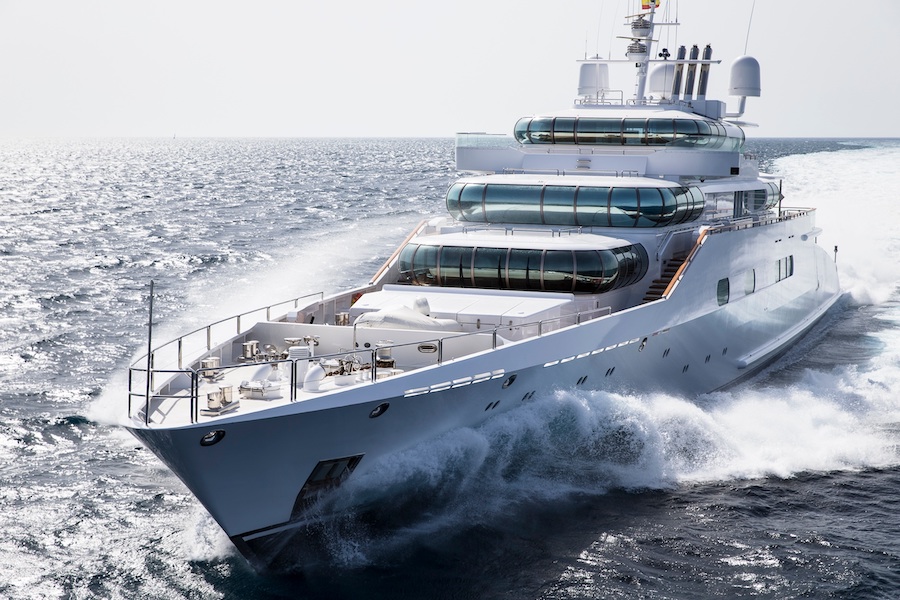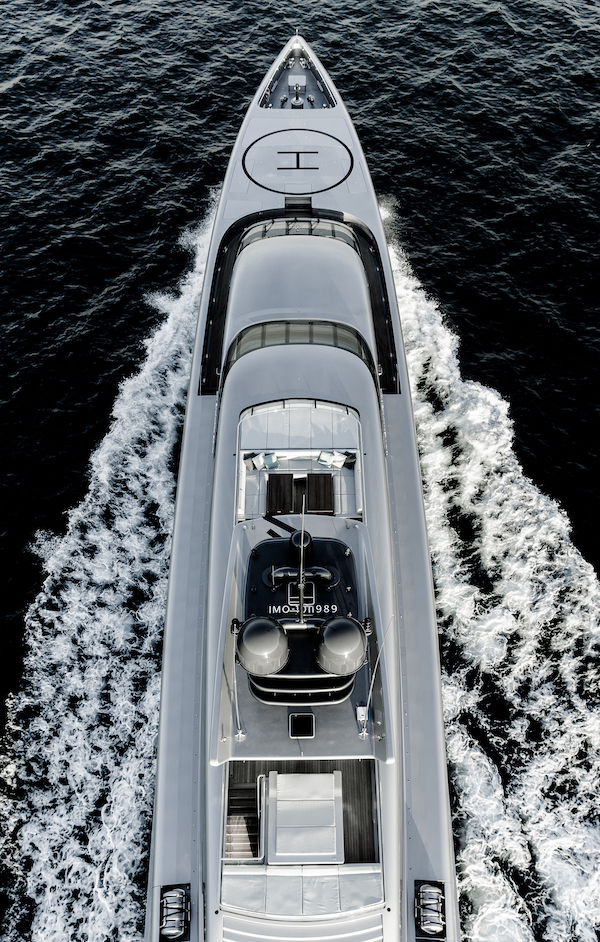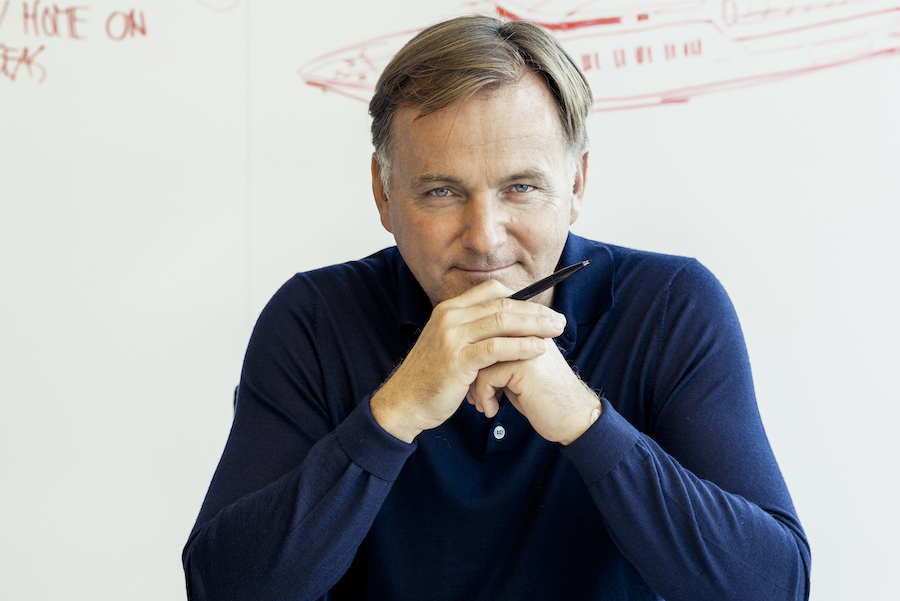So with this backdrop in mind, who better to front the first of a series of Monaco Life forays into MYS 2022 than one of yachting’s most iconic figures of innovation and forward-thinking: Espen Oeino, one of the naval architects and designers of the superyacht industry.
He has been designing yachts since his early 20s; the first, 74.5m MY Eco (now MY Zeus) still ‘bobs’ about in Monaco’s Port Hercules harbour.
Oeino was born and grew up in Oslo, southern Norway, where he skied by moonlight and spent endless summers messing about on boats. He says, “We have a very nice coastline in Oslo and Norway in general and in the summer we had long nights and short working days – it gives rise to an interesting lifestyle. If you include all the perimeters of all the island coastlines in Norway it adds up to 100,915km, which is the second longest coastline after Canada.”
When Espen Oeino was 17-years-old he was packed off to boarding school in Normandy, France. From there it was only a short step across the water to study naval architecture and offshore engineering with a focus on the oil and gas industries at the University of Glasgow in Scotland. “It was ship design basically. I went to university because I wanted to study naval architecture: mechanical engineering and civil engineering.”
The first few years were spent learning about principles and structure then floating structures and stability, hydrographics and hydrodynamics, hull designs.
“I was a passionate sailor so I wanted to design sailing boats,” he reveals.
After an internship with foremost designer Martin Francis, he was offered a full-time job, which is where his involvement with MY Zeus, formerly MY Eco, began. “Martin Francis was invited to tender a design for a motor yacht,” says Oeino. “None of us had ever designed a motor yacht before. We were really the underdogs but we ended up winning the competition and this boat was built, and I ended up being responsible for the project in the office. And that was my accidental entry into motor yacht design”.
Oeino worked with Francis for eight years before starting up on his own in 1994. Nearly 30 years later, the Espen Oeino International studio counts a staff of 30. He’s been designing yachts since he was three or four years old but the first big boat for which he was known was the mighty 126m MY Octopus in 1998. “I think at the time she was the fourth biggest yacht in the world and was certainly the biggest explorer yacht,” he remembers.

For Oeino, the Monaco Yacht Show is an opportunity to catch up with clients and industry friends. Several EO designs also feature in the Show including two new launches built by Amels shipyard: the 60m MY Come Together and MY Energy (78m).
With the introduction of a Sustainability Hub at the MYS this year, is it feasible to talk of sustainable superyachts? Oeino likes to think it is. “Obviously the bigger the yachts, the more energy they require to function, but you need to try to minimise whatever you have to spend to make it all work: use renewable resources and limit the damage in terms of emissions.”
The EO studio is currently working on designs using multi-hulls. The ‘Silver Cat’ is being built in Australia. This 23.9m catamaran has open sides, front and back, to allow for natural air flow and no air-conditioning, limiting that particular energy consumer to the cabins below deck, a bit like a Bali beach house, he suggests. “I experimented a little bit myself with reducing requirements this summer with a small catamaran I built for myself.”
His interest in ‘fast but efficient’ dates back to the early 2000’s and beyond, particularly with the shipyard Silver Yachts. MY Silver Fast (2015), lightweight and slender, was designed to glide through the water with very little power. He is now working with catamarans at the shipyard looking into making the catamaran hull even slenderer than the mono-hulls and addressing the question of transversability.
“I am proud of the Silver Yachts,” he says, “they are very sustainable, and again they were against the mainstream when we built them. The volume is distributed longitudinally when the trend was to go taller or wider. It’s extremely efficient, you can cruise it at 18.5 knots and burn less than 400 litres an hour, which sounds like a lot but it’s not for a boat that size.”

The EO studio is also working on some commercial projects with electric propulsion combined with fuel cells and hydrogen. The life cycle of yachts and their materials are another consideration – the question of the choice of materials and the impact of the life cycle of a yacht. What energy is required to produce the material? How much energy is required to get rid of the material after the life cycle of a boat? “It’s a massive calculation, and we are starting to talk about it, like other industries, but it’s a huge subject,” explains Oeino.
“No-one needs a yacht to live. They do not perform any work like a cargo ship or a ferry – carrying passengers or goods. So, I can always argue, I guess, that it has no purpose and the emissions could be avoided. But there are many things you can say that about. I think that in this industry we realise that sustainability is high up on the agenda and something we have to do our utmost to address. It’s a question of trying to reduce requirements and trying to be as clean as possible with whatever power and power source you are using. The last thing you want is a dirty sea, either the sea around you or the fumes from generators in your face.”
Raising awareness is critical, Oeino says. “If you take a typical displacement yacht of 80m, and bring her from a cruising speed of 14 or 14.5 knots to 17 or 18 knots, you pretty much multiply the power by a factor of 2.5/3 for a speed increase of 3/4 knots – so you’re doubling or tripling the power. This is crazy. So, think about that. Maybe you don’t need to get to St Tropez that bit earlier. That’s a very simple thing to do. The resistance curve is really cubic, it’s not linear; even reducing the speed a tiny bit can save energy and money.”
The man whose finger tips have brought us the world’s most iconic yachts still has ideas tumbling from the drawing board: “What I find interesting,” he says, “is trying to make the most out of whatever you’ve been given.”
Monaco presents MYS 2022… enjoy!
Photo above: Espen Oeino, credit Guillaume Plisson
